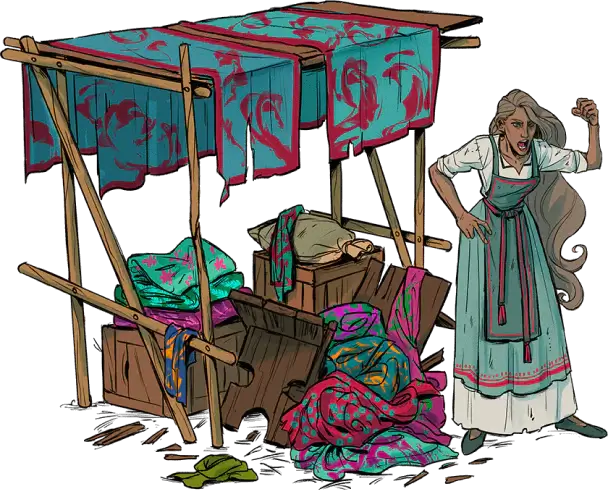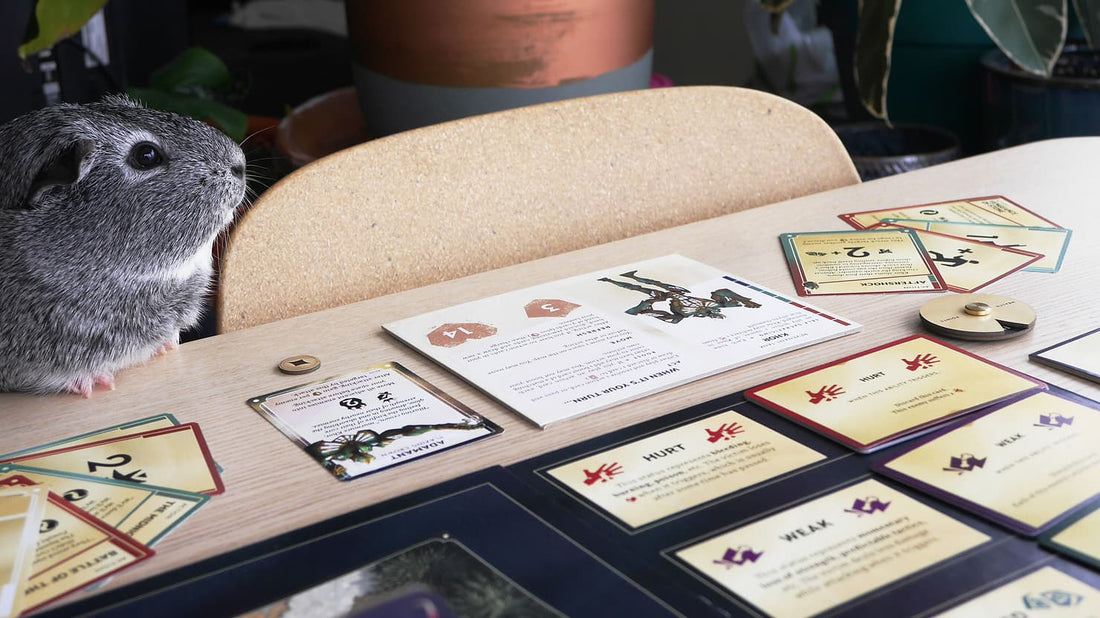So you’ve had an idea for a board game, you’ve developed it to a good working spot, you’ve read our guide on how to know when you’re ready to playtest, you’ve determined that you’re ready, and you’ve found people who want to play your game. Congratulations! Now it’s time to sit down at the table and start playing, right? Well, not quite. You only get to introduce people to a game once, and the biggest mistake a game designer could make is doing too much, or too little, during the playtest.
Hi! I’m Risa, I’m the Community Manager for Incredible Dream, and I’ve been running and/or participating in 2-3 playtests a week for the last 3 months for our upcoming narrative RPG board game, Kinfire Chronicles: Night’s Fall (psst! We’re always looking for more playtesters!). I’m going to take you through running your first playtest, the do’s and don’ts that will make it run smoothly during, and what to do when it’s over. Let’s get started!

One of our Guinea Pigfluencers getting ready to playtest as Khor
What to do while you’re running a playtest
Take notes. As many as you can. Don’t assume you’ll remember everything. If there’s confusion about the wording on a card, make a note of what card it is. If the players do something unexpected, write down what it is. If you can avoid playing so that you have more time to watch and answer questions, even better.
Here’s a few of the notes that I took during a playtest in Kinfire Chronicles:
- ”F’s ability- “one” spent chit, not just pulled”
- ”K use ability to take hurt damage?- No”
- ”2-14 should say “go to 2-12”
- ” ‘am I the kind of person to hold back or jump in?’ “
Those are my 4 main type of notes that I take: rules that need clarification, questions the players have and their solution, changes that we need to make to components, and direct quotes from the player (this last one is most important if you can’t film your playtest, or if you’re typing your notes. If you’re doing it pen and paper style, trying to write out a full sentence might pull your focus for too long).

Some of my notes from a playtest. Don't judge my handwriting.
Let the players interpret the rules. There is going to be confusion during the game. This is to be expected. How many times have you had to consult a rulebook for clarification in a published game? More than once? More than five times? It’s okay if the playtesters get confused. Make a note of what confuses them, and then let them decide how to play. If it’s going to completely ruin the play experience, by all means, step in. But if it’s a minor interpretation, see how it plays out. Maybe they’re clued into something you didn’t think about!
In the notes I shared earlier there was an example of this. Feyn’s special ability reads, “Each time Feyn boosts another hero’s action, he may return 1 of their spent hero chits to the bag.” The confusion came when a heart chit (essentially a “player’s choice” chit) was used to give Khor a turn, but Khor also had their own hero chit already on the table. Feyn boosted Khor, and then went to put Khor’s chit back in the bag. I went to intervene, since the intention was Feyn could only put back the chit that had just been drawn. But by the wording, this player’s interpretation wasn’t wrong. It just wasn’t what I had expected. So I let them play it out and guess what? Feyn’s ability became more powerful! The player had a positive response to it. And it didn’t turn the tide enough to break the game.

Feyn's Hero Sheet
If you need to see something specific, ask for it. If you really want to see how two cards, or character abilities, or turn progressions, play out, ask your players to do it! As we started playtesting Kinfire Chronicles, we rapidly learned who the two most popular characters were, and the common playstyles for each of them. But we were lacking information on how a quest would play out without them, so we had to specifically ask playtesters to choose different characters so we could see different outcomes.
Check your ego at the door. This is easier to do if the person running the playtest isn’t the designer, but if you’re still developing a game and getting ready to pitch it, you might not have the luxury of someone to run the test for you. Just keep in mind that most of the time the people playing your game want you to succeed. They want to have a good time, have a few laughs, and share in a positive experience together. They’re not there to wreck your game or pick it apart. Often, pulling negative feedback is like pulling teeth, because they won’t want to hurt your feelings. But if there’s a part of the game that’s confusing, or they play in a way you didn’t expect, or they just don’t like the game, try not to take it personally.

Part of combat during a Tabletopia playtest of Kinfire Chronicles: Night's Fall
Have a written form for playtesters to fill out. It doesn’t have to be long. But have something for players to fill out before you chat as a group, that way you can get their unbiased, immediate opinion. This is what ours looked like.
What to do after your playtest
Thank the players. This may be obvious, but it’s worth stating anyway. Thank your playtesters for their time, and for their feedback. Depending on where in the development cycle you are, and how much their feedback helped you, you might consider giving them a special thanks in your rulebook, or a copy of the game once it’s produced. If you’re paying them for their time, this isn’t necessary. But thanking them is.
Process. Before you do anything, take the time to analyze your results. Look through your notes and find commonalities (like the most popular characters played, as mentioned before). Consider all the data, especially in the shoes of someone who hasn’t played the game before. Just because one person didn’t like an element doesn’t mean it has to go. Likewise, if a well-received mechanic is still bogging down gameplay, it might be worth running a test without it.

Just one of my many charts translated from written notes
Make the easy changes first. Little things like typos and component amounts (too many or too few) are the no-brainer adjustments that will get the ball rolling and get you in the headspace to make changes. If anything in your notes was an obvious yes, start there.
Playtest a few changes at a time. This might be a privileged position to take, because we don’t all have easy access to playtesters, and especially new playtesters. But if you can, try to introduce your adjustments bit by bit, like a research project. You need a control group. If you change too much too fast, you won’t have an accurate comparison to the game as it used to be.

Tabletopia version of the Destiny Bag, Time Track, and Fate Tokens
Final Thoughts
Watching other people play your game is the most exciting and nerve-wracking moment of game design. …Until you pitch it. …And then when it goes to retail. Game design is a rollercoaster, okay?
The biggest takeaways I can give are:
- Playtest early, and often
- Find a nice diversity of players (ages, skill levels etc.)
- Let the players play the game. You sit back and take notes
- Don’t make every change suggested, but make some changes
- Thank your playtesters
The more playtests you run, the more confident you’ll become, both in your game and in the process.
Have you playtested before? Either running one, or as a participant? What was your experience like, and do you have any advice that wasn’t mentioned here? Let us know in the comments.



